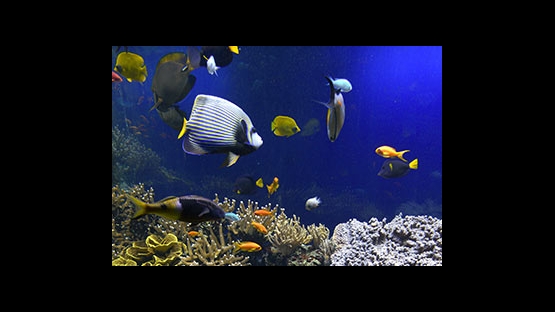Ocean acidification refers to a series of chemical changes in the ocean. Ocean water will become "corrosive" to organisms forming calcium-containing shells or skeletons (such as oysters, mussels and corals), and impair other biological processes, with potential ripple effects through marine ecosystems. The negative effects of ocean acidification have already been seen in oyster hatcheries on the west coast of the United States, where production was significantly reduced threatening a multi-million US$ industry and thousands of jobs.
Nuclear and Isotopic Techniques in Ocean Acidification Research
Past Changes in Ocean Chemistry: Scientists study of the natural radionuclides in coral, seabed sediment and ice cores, which are "environmental archives". This nuclear technique can precisely date and thus map developments in the past. Scientists are able to look into the past and follow trends in ocean acidification that occurred several decades or even millennia ago.
Fossilized marine microorganisms buried in the sediments on the ocean floor or the skeletons of long-lived corals provide a record of acidification. During their lifetime, these organisms formed shells or skeletons whose calcium content depends upon seawater chemistry, or pH, of that time. They incorporated certain chemical compounds into their shells or skeletons, whose presence and quantity depended on the pH of the ocean water at that time. One such compound is boron. Boron has two isotopes, 11B and 10B, and the relative amount of these isotopes incorporated into the shells is dependent on the pH (i.e. acidity) of seawater. The amount of boron found in shells or skeletons offers an indirect measurement of the ocean water's pH many thousands of years ago. The information provided by such registered data is not only useful to find out whether ocean acidification happened in the past, but also crucial to test and build models to project future acidification scenarios.
Impact of Ocean Acidification on Seafood Security: About one billion people rely on seafood as primary source of animal protein. Radio-tracer experiments can help us to understand how marine organisms might respond to future ocean acidification. Biological processes such as primary production, growth and calcification can be measured using isotopic techniques. The information provided can be used to estimate the impact of ocean acidification on key commercial species and help evaluating risks for the environment and for society, e.g. implications for shellfish production and ultimately seafood security.
Impact of Ocean Acidification on Seafood Safety: Nuclear and isotopic techniques can be used to detect and monitor biotoxins produced by harmful algal blooms (via a "radio-ligand receptor binding assay", RBA), accumulating in coastal areas and in seafood. It is believed that ocean acidification in combination with other environmental stressors (e.g. global warming) will increase the frequency and severity of harmful algal blooms. In addition, future changes in carbonate chemistry and pH are expected to alter the availability and uptake of toxic heavy metals in marine organisms. Radioisotopes can be used to study the toxicity of these elements in marine organisms.
IAEA's Work on Ocean Acidification
The IAEA Environment Laboratories in Monaco support the IAEA Member States in their use of nuclear and isotopic techniques to increase their understanding of the marine carbon cycle and the effects of ocean acidification on marine organisms. In addition, the IAEA is involved in several projects investigating the economic consequences of ocean acidification.
The Monaco Laboratories also operate the Ocean Acidification International Coordination Centre (OA-ICC), a project launched at Rio+20 in response to recommendations from the scientific community and to the growing concern of IAEA Member States. The project works to communicate, promote and facilitate a series of international ocean acidification activities, such as the establishment of an international observing network, collaboration between natural and social sciences, fellowships, definition of best practices, bibliographic database, data management, capacity building and communication. It serves the scientific community as well as science users (policy makers, the general public, media and other stakeholders).
The OA-ICC is supported by the IAEA Peaceful Uses Initiative (PUI), and by several Member States and research projects on ocean acidification. An Advisory Board of key international institutions and leading scientists in the field provides feedback to the project.


